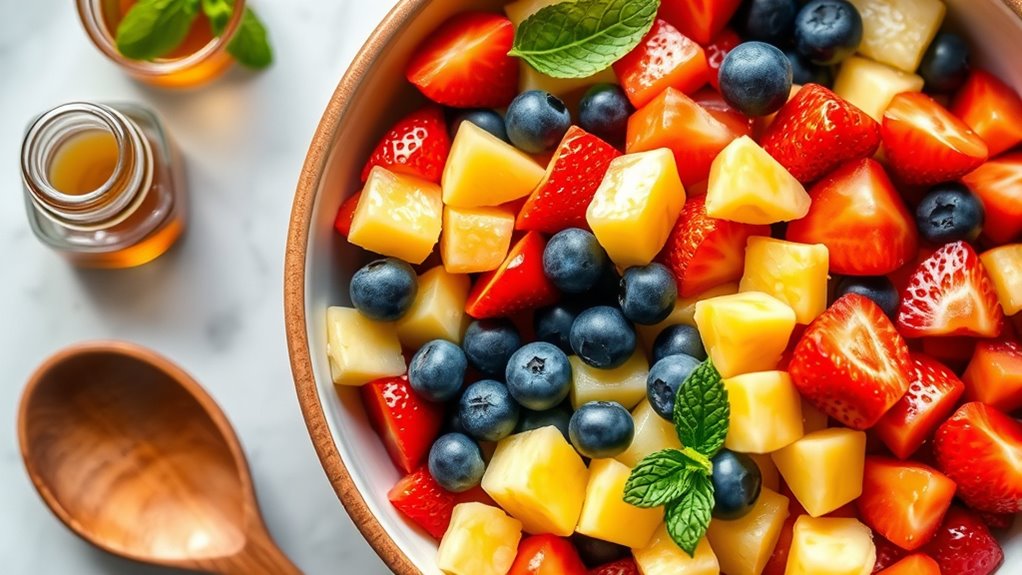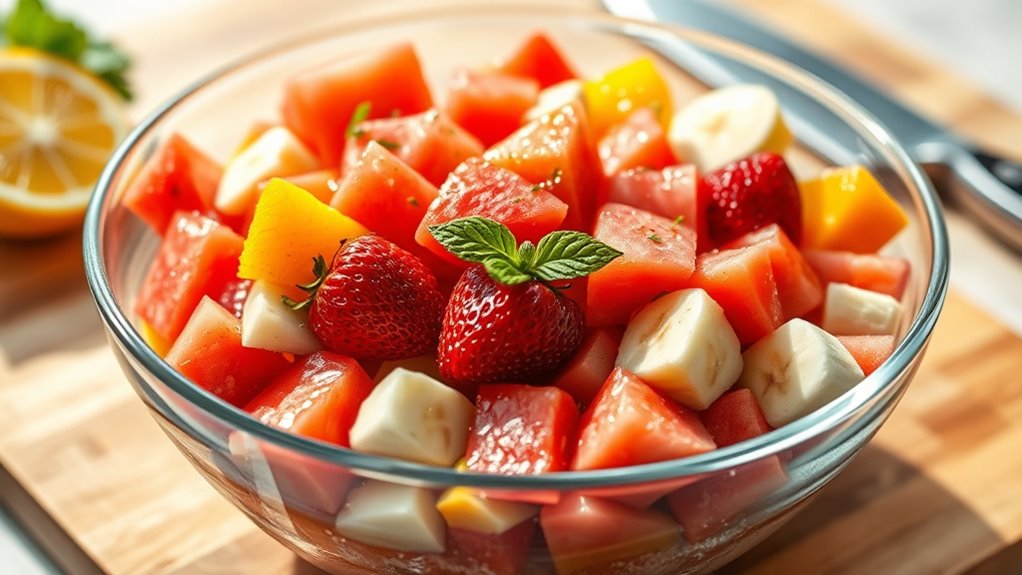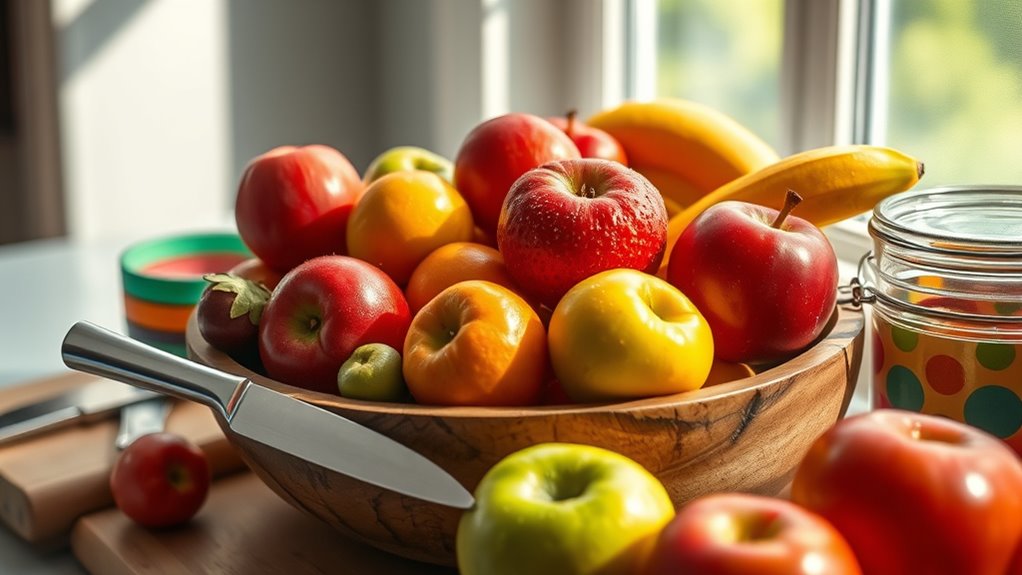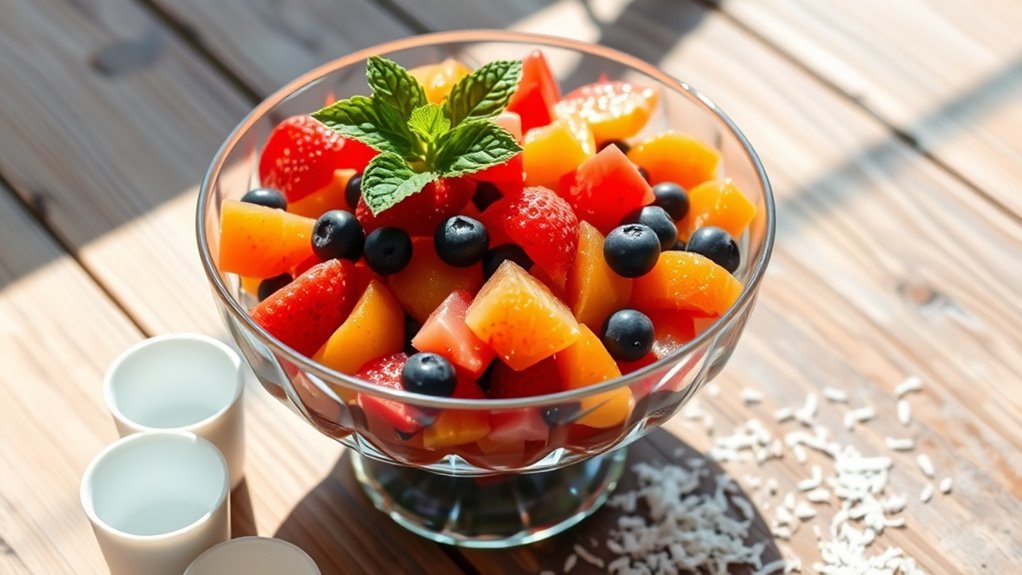Start with ripe, bite-sized fruit: strawberries, pineapple, mango, blueberries, and green grapes, trimmed and washed, so each piece holds its brightness. Toss gently in a clean bowl, a light drizzle of lime juice, and a whisper of mint to wake the flavors without overpowering them. Use uniform cuts for even flavor release, then chill briefly to deepen the freshness. Serve plainly or with coconut flakes or yogurt for a creamy contrast, and discover more tips ahead.
Ingredients and Quantity

Gather fresh fruit you love: 2 cups strawberries, 1 cup pineapple chunks, 1 cup diced mango, 1 cup blueberries, and 1 cup green grapes, plus a drizzle of lime juice and a pinch of mint. You choose what sings to you, balancing fruit selection and portion sizes for effortless flavor. Start with clean, ripe pieces, then trim edges for bite-sized bliss. This is your freedom to mix textures, colors, and sweetness. Keep portions honest to prevent overload and keep the dish lively.
| Fruit | Quantity | Notes |
|---|---|---|
| Strawberries | 2 cups | Hull and slice |
| Pineapple | 1 cup | Diced fresh |
| Mango | 1 cup | Diced |
| Blueberries | 1 cup | Whole |
Preparations

Now that you’ve chosen the fruit, set the stage for prep by washing everything gently and patting it dry. You’ll notice the cool drip of water and the soft patter on towels as you collect each piece. Move with intention: inspect for bruises, remove seeds if needed, and separate fruit by type to keep flavors distinct. For fruit selection, aim for ripeness that’s firm yet yielding, vibrant color, and aromatic sweetness. Cut with clean, confident motions, keeping pieces uniform for even flavor release. Use preparation techniques that minimize juice loss and preserve texture. Toss fruits with a light hand, so no single piece dominates. Chill briefly if you crave brightness, then fold in a final, shiny gloss of citrus juice.
Kitchen tools or Kitchenware Required

To prep a fruit salad smoothly, you’ll want a small, sturdy setup: a sharp chef’s knife, a clean cutting board, a paring knife for precision, and a sturdy bowl for tossing.
| Tool | Purpose |
|---|---|
| Cutting board | Safe surface for slicing fruit. |
| Mixing bowl | Toss fruit evenly without making a mess. |
You’ll feel the crisp snap of each bite as you rinse, then trim, then slice. The knife’s weight anchors your hand, the cutting board keeps cuts clean, and the mixing bowl invites you to fold fruit with calm, careful motions. Freedom comes in organization: clear space, ready tools, and a rhythm you control. This setup makes every slice sing, every color pop, and every bite feel effortless.
How to Cook

- Focus on balance and timing rather than heat or speed when making fruit salad.
- Select ripe fruits by prioritizing fragrance, color, and moderate sweetness.
- Choose a variety of textures such as crisp apples, juicy berries, and meaty mangoes for contrast.
- Wash fruits gently and pat dry to maintain freshness.
- Slice fruits into uniform pieces with clean edges.
- Mix fruits using folding or gentle turns to preserve juices and structure.
- Layer fruits by moisture level before mixing.
- Finish with a light drizzle of citrus to enhance flavors without overpowering.
- Keep the salad simple, allowing natural sugars to guide the flavor balance without heavy additives.
How to Serve

Choosing how to serve fruit salad is about preserving the bright, fresh notes you’ve built. You’ll keep textures lively by presenting chunks that aren’t overstewed and by avoiding heavy syrups. Think about presentation styles that highlight color contrast: a clear glass dish to show layers, or a rustic wooden bowl for casual picnics. Serve in portions that feel effortless, with a breeze of mint or a light citrus zest for aroma, not overwhelm. For serving suggestions, consider guest preference—small cups for easy tasting, larger shared bowls for gatherings, and a topping lineup that’s optional, like coconut flakes or yogurt dollops. Keep it simple, accessible, and vibrant; let the fruit do the talking and invite everything to be shared.
Tips
Here are quick tips to keep your fruit salad bright and inviting: pick fruits that ripen at similar times, but pair contrasting textures—crisp apples with soft mango, tangy pineapple with delicate berries—for a dynamic bite. You’ll want Fruit selection that balances sweetness, acidity, and juiciness, so choose a rainbow of colors and flavors that hold up when you chill. For Dressing options, keep it light: a splash of citrus juice, a whisper of honey, and a hint of mint elevate without overpowering. Toss gently to coat without bruising. Chill briefly to marry flavors, then serve. Trust your senses: if something feels ripe and vibrant, fold it in. Aim for refreshment, not heaviness, and let freedom guide your combinations.
Food Value and Benefit
Fruit salad isn’t just bright and tasty—it’s a nutrient-packed dish that nourishes your body with every bite. The combination of fresh fruits provides essential vitamins, minerals, fiber, and natural sugars that contribute to overall health and well-being.
Food Value of Fruit Salad:
- High in hydration due to water-rich fruits
- Rich source of dietary fiber aiding digestion
- Contains natural sugars for quick and sustained energy
- Packed with antioxidants that protect cells from damage
Nutritional Benefits:
- Supports immune function through vitamin C and antioxidants
- Promotes healthy skin with vitamins A and E
- Enhances digestion with fiber and enzymes
- Provides minerals like potassium and magnesium for heart and muscle health
- Helps maintain steady energy levels without sugar crashes
Key Vitamins and Minerals in Fruit Salad:
- Vitamin C (from citrus fruits, strawberries)
- Vitamin A (from mango, papaya)
- Vitamin E (from kiwi, berries)
- Potassium (from bananas, melons)
- Magnesium (from berries, bananas)
Enjoying a fruit salad regularly helps you stay hydrated, supports your immune system, boosts energy naturally, and promotes overall vitality. Its colorful variety also stimulates your senses, making healthy eating a pleasurable experience.
Frequently Asked Questions
Can I Make Fruit Salad Dairy-Free?
“Where there’s a will, there’s a way.” Yes, you can. You’ll use dairy alternatives and bright fruit combinations, savoring creamy texture without dairy while enjoying freedom in every bite, tactilely invigorating and sensory, crisp, zesty, naturally vibrant.
How Long Can Leftovers Stay Fresh?
Leftovers stay fresh about 3–4 days in the fridge if you refrigerate promptly, keep covered, and avoid sliced apples turning brown. For leftover storage, usp: seal tight, label date, and refresh with citrus to boost freshness tips.
Is There a Vegan-Friendly Dressing Option?
Yes—you can. Try vegan dressings like lemon-tahini or mango-coconut yogurt, creamy yet bright. Pair with fruit salad toppings that spark your senses, celebrating freedom in every bite. You’ll taste zesty, silky, and naturally sweet harmony.
Can I Freeze Fruit Salad Safely?
Yes, you can freeze fruit salad, but use proper freezing techniques and choose firm fruit. For best texture, thaw slowly and enjoy soon; pick fruit with stable flavors, and avoid watery varieties to guarantee vibrant, lasting flavor and freedom.
What’s the Best Fruit to Start With?
Seasonal fruits shine best to start with, you’ll love the crisp sweetness. Think vibrant mangoes or pineapple for tropical varieties, and apples or berries for seasonal fruits, offering flavor freedom and sensory brightness from the very first bite.
